095 #hthv3 #nations
Hackathons are grounds for technical-artistic experimentation, collaboration, and partnership. We research and hack on a familiar backdrop at the United Nations.

A consortium of peers met in Geneva in November 2023 at Hack the Hackathon (HTH v3). You can read more about this in part I and part II on this blog. During this workshop, we discussed the practice of hackathon organizing, and took the unique opportunity to participate in a test-run of a new hackathon format with a venerable institution of the United Nations.
Learn the story here of the peacocks in my picture above.
Indeed, the UN was already a hot topic during the past weeks, as several of us were involved in the well-established event: the UN Datathon. Over 400 teams from around the globe took part in a series organized to support the Sustainable Development Goals through data collaborations:
This year’s theme is SDG localization – the need for local responses and monitoring to achieve the Global Goals. Local responses are essential for ensuring that no place is left behind, and localization is one of five key enablers for accelerating progress towards the SDGs. (data4sdgs.com)

I coached a student team in the use of spatial statistics, who produced some tidy predictions of the energy ratings of buildings in the Canton of Geneva. The local teams worked in the same SDG Solution Space, as the HTH workshop. The project I am about to describe only included participants of HTH, and took place at the UN Library & Archives.
The challenge
We were told that we are here to implement a hackathon setting, that our conduct should be exemplary of hackathons, and that our work today would be evaluated as a potential format for the 2024 Summit of the Future. We were given some time to read into the report from the High-Level Advisory Board on Effective Multilateralism (HLAB).

One leading statement from Shift Five caught my attention:
In addition to traditional military threats, we now understand that a wide range of social, political, economic, and environmental factors play an important role in our security. The interconnected nature of this risk landscape gives rise to our call for collective security, recognizing that countries and their citizens can only feel safe when all feel safe. Rather than a negative and reactive approach, collective security is a vision of positive peace that can be achieved if peace is treated as a global public good.
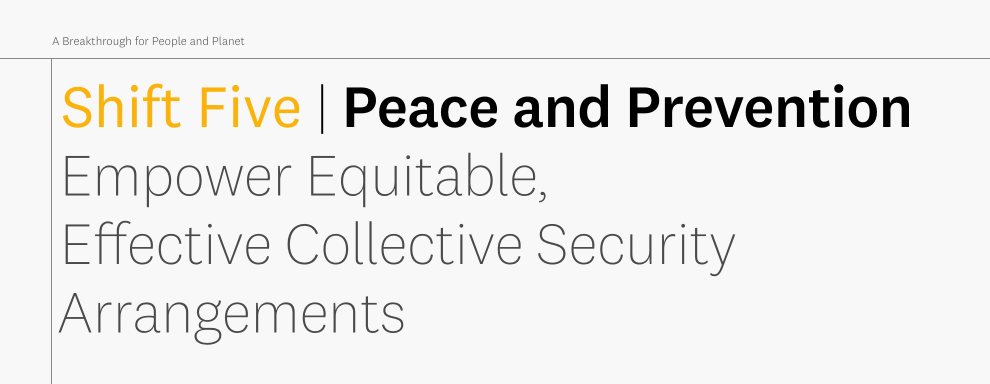
Executive Summary
This project responds to Shift Five - Peace and Prevention, as well as Sustainable Development Goals 16 and 17. Our proposition: Hackathons are the ideal grounds for technical-artistic experimentation, collaboration, and partnership. As proof of concept, we quickly analyzed, researched and published a new article about “The Dream of Peace”: a prominent historic artwork, and a familiar backdrop to research and communication work at the United Nations. Our belief is that this artwork serves as a daily reminder of the universal paradigm of prevention and peace, echoing Recommendation 1: “Commit to our collective security”. This was confirmed by collaborators from the UN Library & Archives, who were open to our ideas and very helpful in research efforts. Our project suggests a few ways in which Artificial Intelligence, Digital Archives, and Open Collaboration within a hackathon setting can support, promote, and venerate sustainable peacemaking processes in the future.

We began our trial hackathon with brief challenge statements on stage. Among the dozen or so, were these two proposals:
- Bringing together people who do not have anything in common to do stuff together is a powerful way to bring sustainable peace. Hackathons are an instrument for peace as they build on the diversity of perspectives of people who do not necessarily know each other. (Thomas, Yannick)
- A virtual art studio inspired by Henrik Sørensen. In the center are symbols of the issues. Above the warring sides, the steps towards a peaceful and diplomatic solution are visualized. The generative paintings are easily hackable, revisions made by other AIs or humans shown next to them. Stretch goal: generative music for peace. (Oleg)
These two statements were soon combined, as we agreed to work together as one team. You can find here the results of my short sprint together with Thomas Maillart and Yannick Heiniger. This included:
- The brainstorming and moodboarding of our ideas
- Artistic and A.I. interpretations of The Dream of Peace
- A new Wikipedia page for The Dream of Peace painting
We are most thankful to Adeline, Christina and Colin, staff members of the UN library, for their valuable inputs and assistance to find the references and power up our project. Without your support, we would have been hacking blind.

Brainstorming
- Use art to make hackathons more bounding to strengthen communities - any type of hackathon, even the most technical, should integrate art and science.
- With hackathons, technology itself is not the end purpose: and we know that art is vital.
- Celebrate the failure of technology (post about blue screen) => humorous, “scandalous”, etc.
- Art for inter-cultural understanding. Art for healing. Art for transcendence.
- What is fascinating about the event here, is that it is structuring skillsets, and the “good” spirit. What Art could add to this ?
- Hackathons mirror the problems of society.
- Mental state and art: mental health in hackathon matters.
- Hackathon: Taking conflict on leash ! ⇔ Peace => handling conflict in a positive way !
- Finding the roots of hacker D.N.A., the common ground, iteratively and improvisationally.
- Let’s play music with friends to wind down after the co-creation.
- “Shared data on peace should be considered a global public good”: hackathons based on open data, bolstering understanding of the costs of conflict and the pathways to peace should be part of the global security architecture.
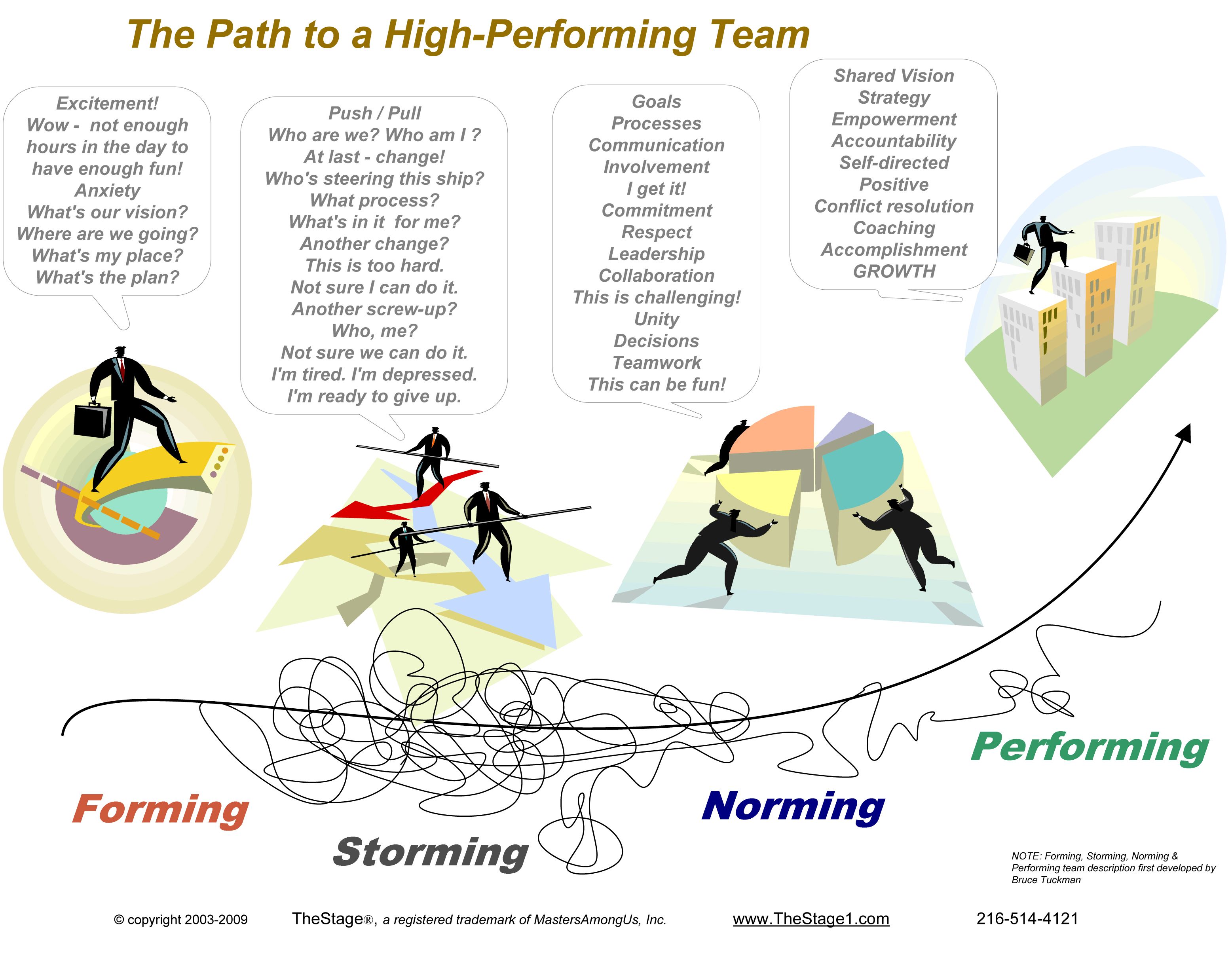
Image from a Wordpress blog via Pinterest that we discussed: a popular metaphor of conflict-management in teams that leads to cooperation.

A painting by Abbas Almosawi of the Roundabout monument, donated by Bahrain to the United Nations Human Rights Council (Photo by Oleg, CC0)
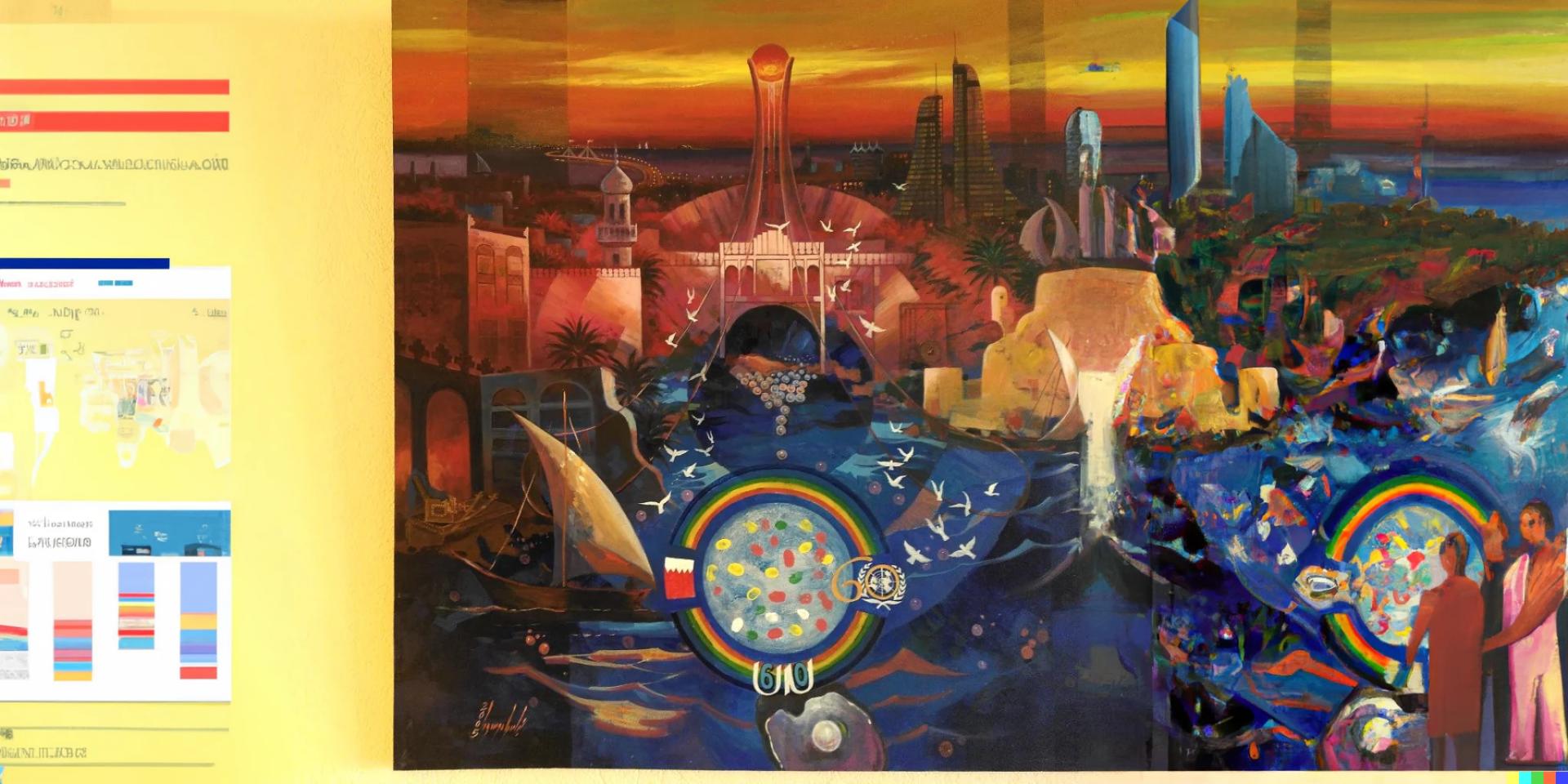
The same painting "extended" with the help of generative AI (DALL·E) as part of the brainstorm.
Research
Our brainstorm led us to think more deeply about the gigant painting by Henrik Sørensen, the centerpiece of the UN space where we worked. With its position behind the speakers, it has physical dimensions that are, at least at hackathons, usually reserved for team presentations. In other words: every public discussion or presentation in the Library would inevitably have participants take in some of the artwork. We pondered on that for a while.
During our study of several volumes of literature, helpfully provided by staff members of the Library & Archives, we made an interesting discovery: the painting was not a solo work, but, a team effort! This is not surprising, considering the scale of the artwork. Nevertheless, this is not a widely known fact - and we hope that these technical assistants - Georg Jacobsen and Cathrine Riddervold, along with the “ideator” Halvdan Koht, will be given due credit through scholarly research in the future. Learning this further sparked our inspiration to contribute more.
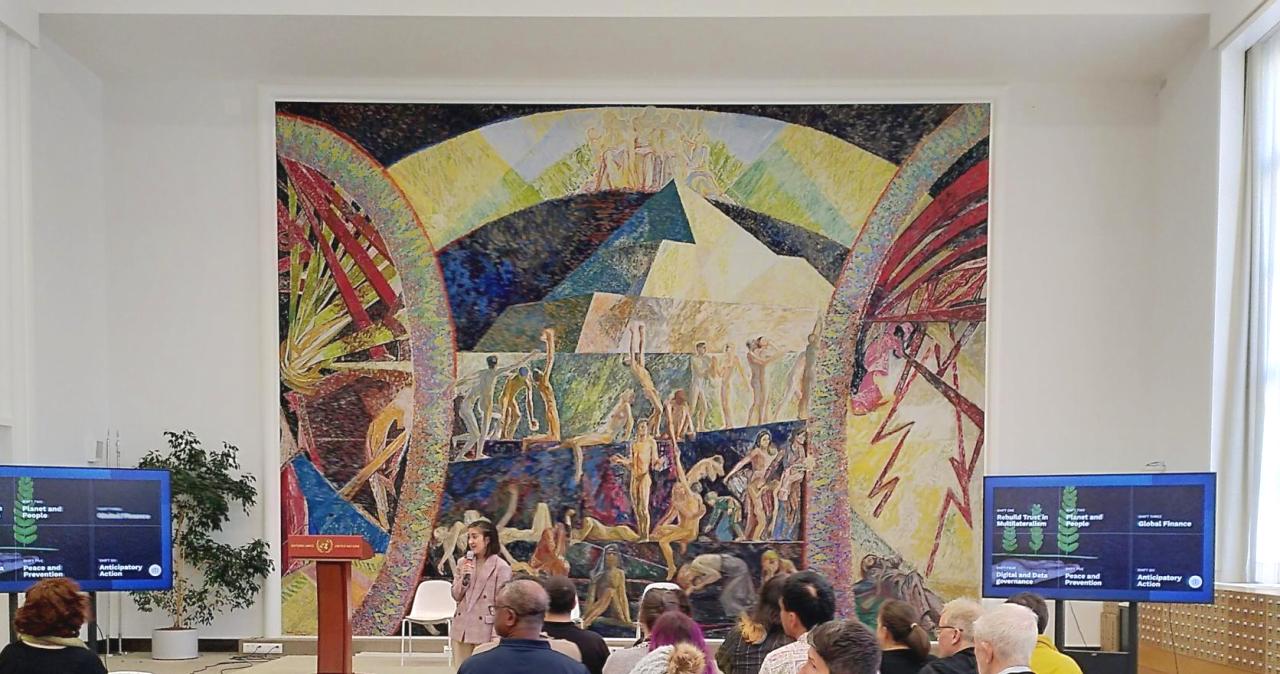
Speaking of inspiration: photographs do not adequately represent the scale and grandeur of the painting. It is quite a visceral experience to approach it, to see that the people in the foreground are almost life-sized, to experience the many layers of a painting which refuses to play a decorative role, provoking our compassion, or angst. There are a lot of hidden details, some of which are described in a leaflet that is available in the room.

This transcript is from that leaflet, of an interpretation written by the artist:
“The Dream of Peace! The left part of the picture provides an image of the totalitarian war. A home in happy blue, rose and green colours. The child sits in the middle. All this is splintered by the war. To the right, the human being as a uniformed machine, in the position of Golgotha. These two images of destruction create the dream and demand for the millennium – the definitive peace. The two arcs created by the colours of these two areas have a form based on the ornamentation of light. At the top of the picture the arcs create an area with the mothers of five continents and their children, symbolising peace.
The central motif is the pyramid, symbol of the ancient ascending principle. At the bottom are the defeated people, the unhappy mothers with their children. In the middle sits the oriental woman – but with a dash of blue hope over her bloody headdress. To the left are the two human birds, the “Paolo and Francesca” of the time – the humans clutching to one another in hard times.
In the axis of the pyramid the new human being rises with the shadows from the level of destruction of the picture. To the right, the persecuted people, refugees and children of famine – but in the green colour of hope. In the middle level of the pyramid the colour of light and darkness meet.
– Henrik Sørensen, October 1939
The hack
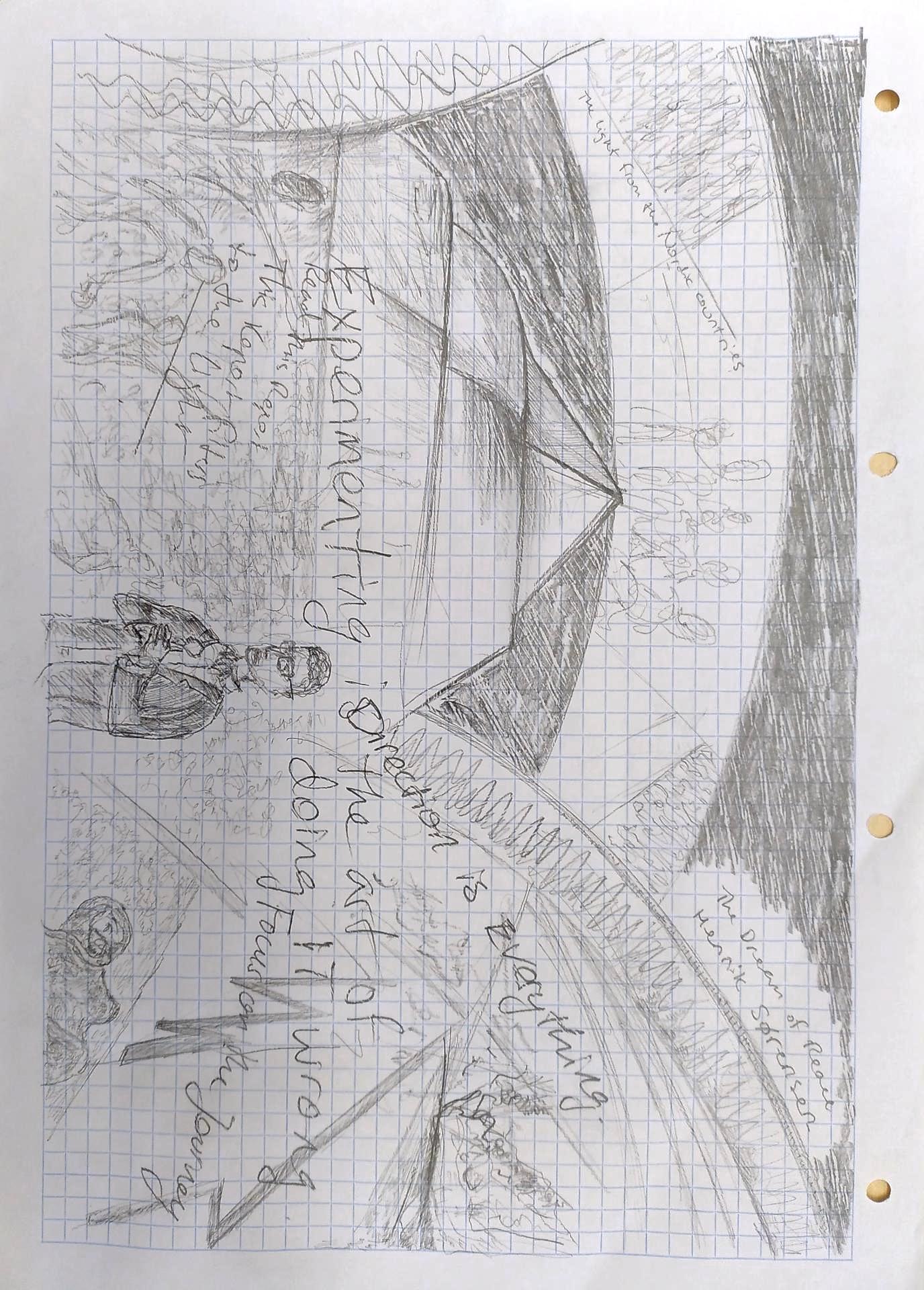
Already during the introduction presentation, I made this 'analytical' sketch of the painting. In front of it stands Francesco Pisano, Director of the UN Library & Archives, welcoming us to the event today. The words of the address are noted inside and around the subject matter and characters of the artwork.
Responding to the stated challenge, to "experiment in the art of doing IT wrong", we uploaded our smartphone photograph of The Dream of Peace into Stable Diffusion, an open source model for generative design based on artificial intelligence. We combined this with prompts like “pacifism, culture, technology, vision of the future, robotic society” to generate several A.I.-interpretations of the work of art. The work of millions of invisible authors was behind the deep remixing and compositing of these pixels.
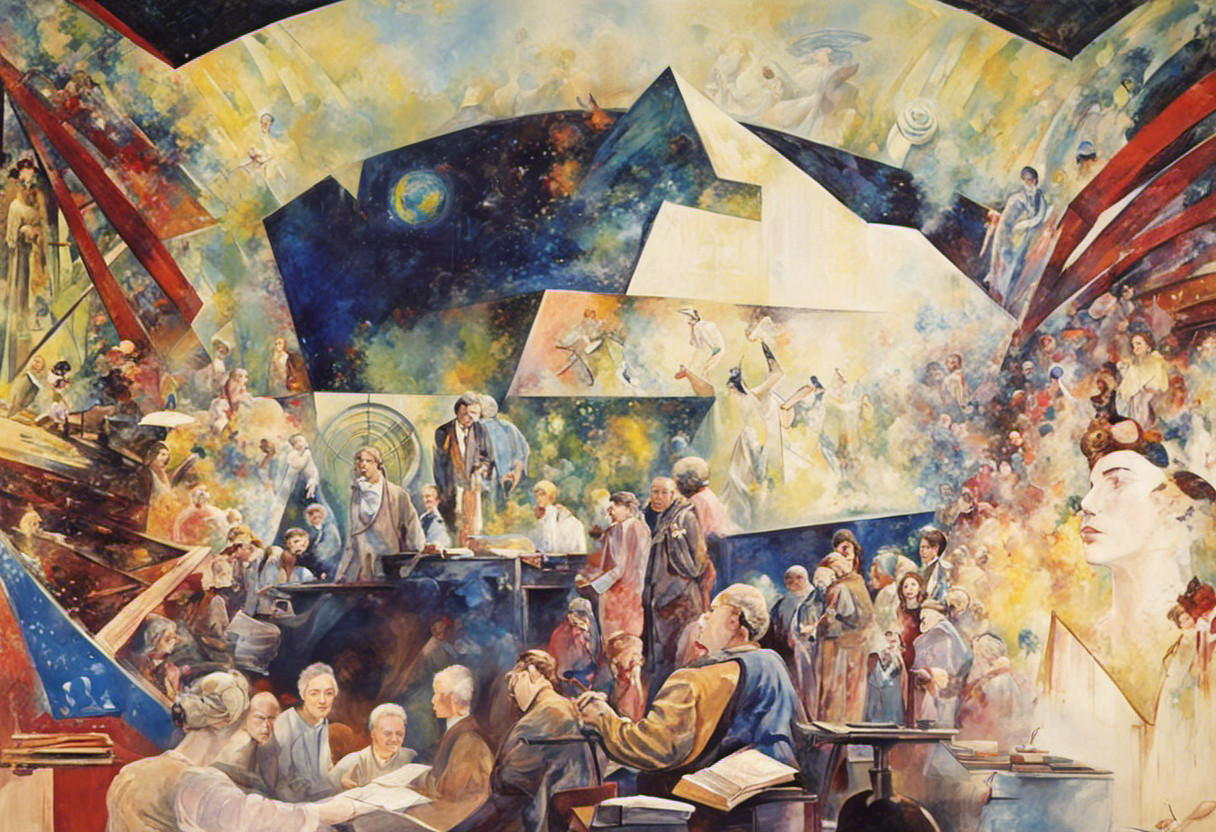
We combined the best versions using open source photo-editing (GIMP) for the final rendering above. A new composition that juxtaposes Sørensen's structures with visions of the future: the Earth seen from space, humans of many cultures, birds and animals, the United Nations Logo, scholarly work and debate. These are embedded into the structure of the original painting. Notice how the central element, the pyramid, is misshapen by a dent, symbolizing (perhaps) the costs and compromises of peacemaking.
To reinforce the original subject, we tried to introduce some violent imagery through further prompts - at least to bring back the dying soldier of the bottom right in the original painting. Our attempts failed, most likely due to limited prompt engineering skills. We prefer to think that the A.I. model was blocking us from doing this from an encoded moral ruleset. In that sense, by refusing to dream up war, the machine could arguably fulfill the premise of a “Dream of Peace”.
As a next step, we would propose a community gallery of interpretations of the painting, inviting discussion, evaluation, further artistic intervention and wider investigative collaboration. We did not make good on our 'stretch goal' of generative music, but hope that there will be another chance to do so in the future.
The commons
During our investigations, we saw that there was no entry on Wikipedia documenting the The Dream of Peace - in French, “La rêve de la paix”. We decided to dedicate our remaining time and energies to proposing its creation, encouraging further research into the topic.
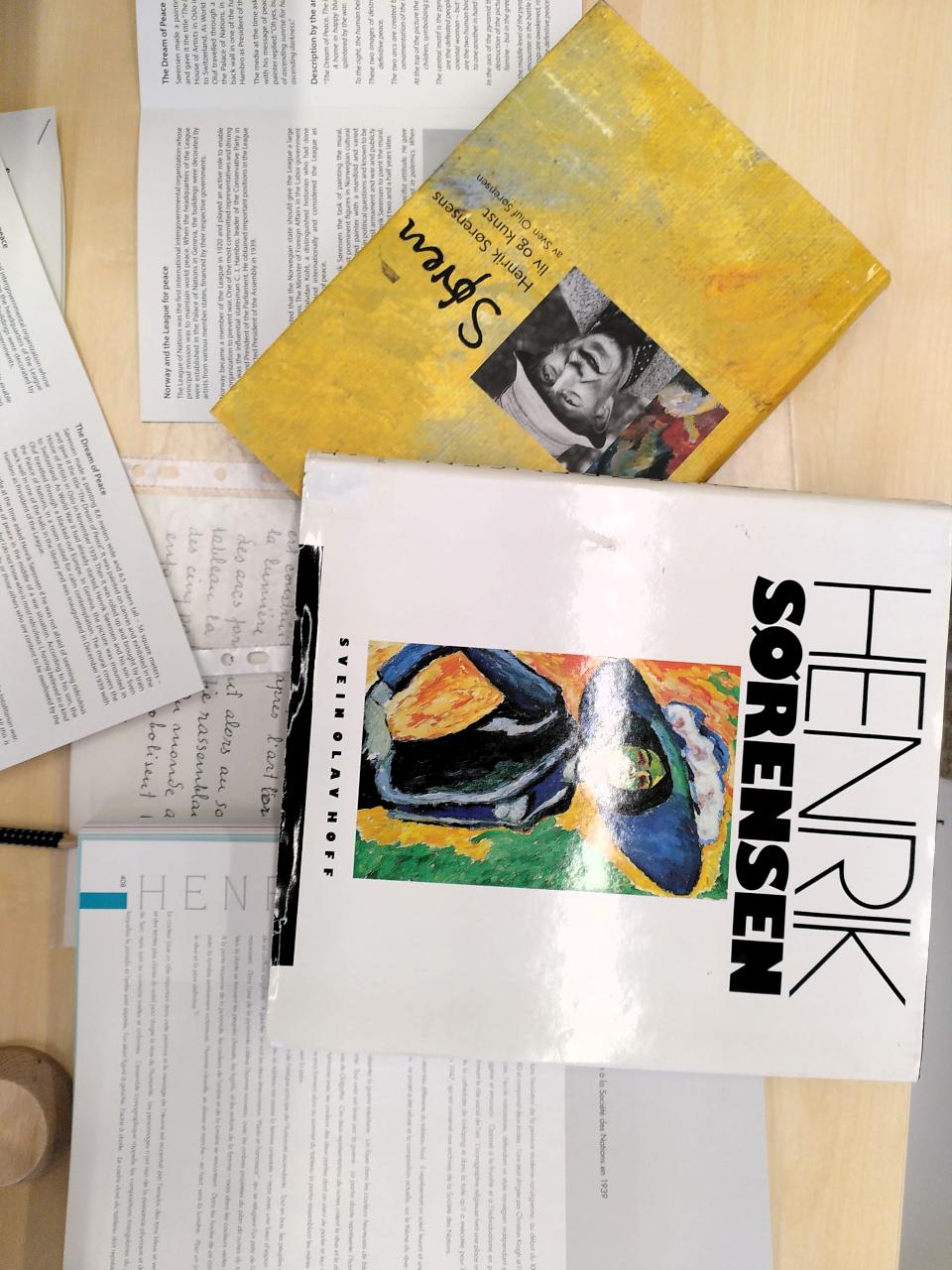
At time of writing, our draft article still needs redaction to get approval from Wikipedia editors. The current submission status can be seen at Draft:The_Dream_of_Peace, or you can scroll down to read our initial version.
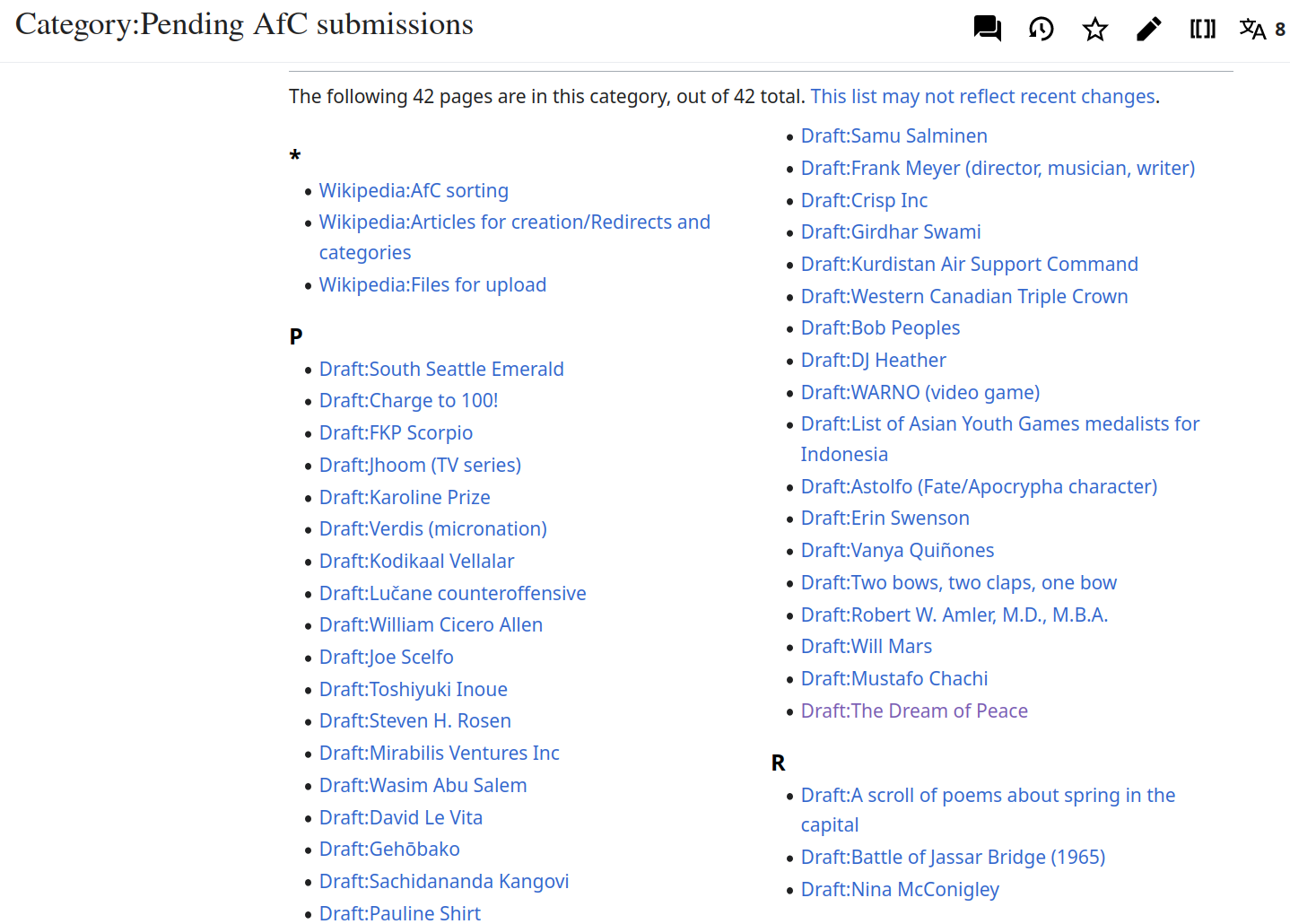
Learnings
Did we manage to bring the hacker spirit to the UN? I think the excitement in the room was palpable, as our colloqium jumped into action - if not to save the planet, then at least to uphold the virtues of our designs.
Will hackathons be a part of future negotiations or mediations? As a cottage industry of midnight-oil-burning amateurs working on random tasks, I doubt it. If we stay true to (in my partner's words) "above all, the people matter" - that we are not just creating another factory to turn minds into product - then I think there is a fighting chance. We would still need to prove that our kind of hack-diplomacy could become a viable ingredient in helping to shed clearer and fairer perspective on the cyber-issues of our times.
While I await the better measured opinions of my erudite fellows, I would say that we have shown how the versatile methods of hackathons could be adapted to meet certain strategic needs of Effective Multilateralism. In our micro-assembly, I hope the UN staff could see that there is a lot more to hacking than creative disassembling, data gathering, perpetual beta, or hype cycles. In the interface of human and machines, there are contingent behaviors and social factors that are well supported by time-limited collaborations, modelled in the best traditions of open experimentation and teamwork.
As the world's most incipient mediator, the United Nations can inspire our whole community to strive for sustainable, humanitarian goals - far beyond the baseline. The experience has certainly made an impact on my outlook, and I want to see Human Rights, the SDGs and the Shifts upheld in more hackathons. As a software maintainer, browsing the UN Library & Archives has made me wonder about embedding these in our Codes of Conduct. I had thoughts about how platforms like Dribdat (documenting the recent GLAMhack in Geneva) and Policy Kitchen (from our friends at Foraus) could be useful for mediative process in all kinds of communities.

To wrap up my blog post, in gratitude to the organizers and visionaries keeping the world's people banded together in these harried times. I leave you with a quote from a hack - a writer - who loved to think a different world was possible, and to write these dreams up for our world to know.
“What egotism, what stupid vanity, to suppose that a thing could not happen because you could not conceive of it.”

Draft: The Dream of Peace (painting)
The Dream of Peace is an 8.6 meters wide and 6.5 meters tall canvas oil painting by Norwegian artist, Henrik Sørensen (b. 1882 – d. 1962), depicting themes of war, defeat, and hope for humanity. It is on permanent display in the United Nations Library & Archives in Geneva.
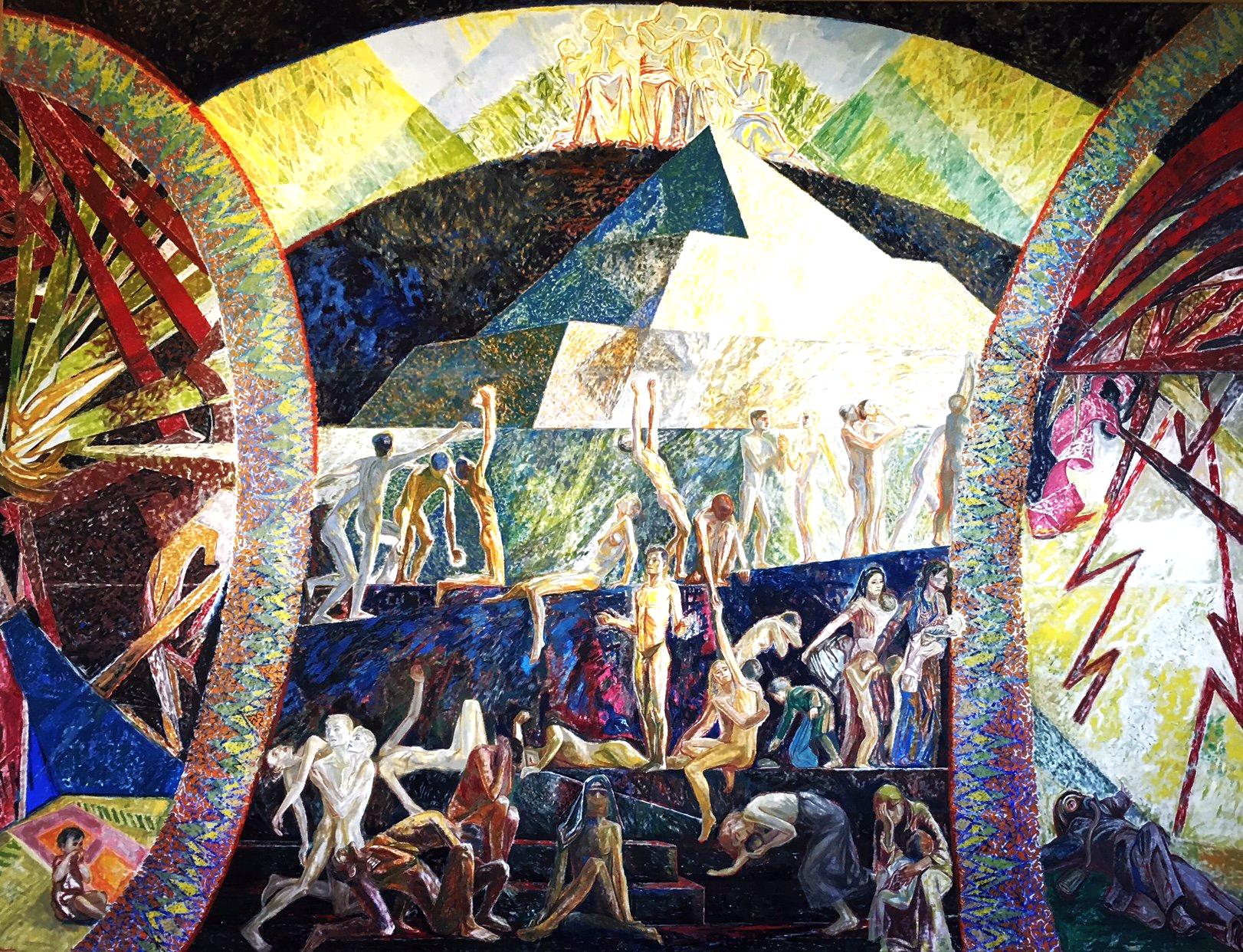
History
Commissioned in 1937 by the Norwegian government, it was over two years in production[1]. Several other painters contributed to the painting. The constructivist Georg Jacobsen, extraordinary professor in the period of 1936-40 at the Academy of Fine Arts in Oslo, designed the pyramid. Sørensen had a student, Cathrine Riddervold, who acted as an assistant: among other things, painting the two large ornamental arches that separate the pyramid from the two side panels.[1]
It was Halvdan Koht - at the time Norway’s Minister of Foreign Affairs - who together with Carl J. Hambro - then President of the Parliament - made the commission that put the painters to task.[2] After being shortly displayed at the House of Artists in Oslo in November 1939, the work was rolled up and brought by train to Geneva[2]. There it was mounted in the Palace of Nations to adorn the Great Reading Room of the United Nations Library & Archives, a place of calm and contemplation[2]. The mural was inaugurated in December 1939 in the presence of C. J. Hambro, the then-President of the Assembly of the League of Nations.
Composition
The initial sketch of The Dream of Peace was quite different from the final painting. It depicted a rising sun and a frieze featuring portraits of the founding fathers of the League of Nations idea. The project was rejected, and the current composition, themed around the dream of peace, was chosen. The artist describes the work as follows:
The left part of the painting aims to represent totalitarian war, with a hearth in happy colors of blue, pink, and green. The child occupies the center of this section, all of which is shattered by war. The right part depicts man as a standardized machine, deployed in a Golgotha pause. These two representations of ruins create the dream and the right to the millennium, and to ultimate peace. The two arcs harmonize with the colors of the two aforementioned parts. Their pattern is constructed on the monumental art of light. At the top of the painting, The arcs form the section gathering the mothers of the five parts of the world, with their children, symbolizing peace. The central motif represents a pyramid, which is a symbol of the ancient principle of ascending humanity. At the bottom are the defeated peoples, the unfortunate mothers, and their children. In the middle of the painting sits the oriental woman, with a glimmer of blue hope above her bloody headdress. To the left, wo bird-like beings, "Paolo and Francesca," take refuge near each other in difficult times. In the axis of the pyramid rises the new man, with the projected shadows of the ruins' plan in the painting. To the right are the displaced peoples, the refugees, and the children of famine—but in the hopeful green colors. In the middle part of the pyramid, the colors of shadow and light meet. In the surges of this battle between shadow and entirely victorious light, man awakens, stands, and walks—upwards, towards the light. For one day... to meet the dream and the definitive peace.
Color plays a crucial role in this painting. The message is emphasized by the use of blue and green tones, colors of hope, and lighter hues of the sun to guide the dream of humanity. The characters lack physical power and majesty. On the contrary, they are instead slender and uniform. The iconographic ensemble recalls the triangular compositions of the Last Judgment, where paradise and hell are separated, one depicted on the left and the other on the right. The golden frame of the painting is meant to represent a halo.[3]
According to the artist’s son, Sven Oluf Sørensens, when asked for the seemingly ridiculous message of peace in the middle of a war, the painter replied: “Oh yes, but I do not know who is most ridiculous: I, having believed in a kind of ascending sunrise for humanity, or those others who are content to be swallowed by the ascending darkness.”[2]
References
- The Dream of Peace. Leaflet. Permanent Mission of Norway, in close collaboration with Ms Torild Skard. April 2019 UN/LIB/2019/16
- La Représentation de l’humanité. Page 408. Anneleen de Jong, Nations Unies, 2001. UN/LIB/2001/68. ISBN 92-1-200357-5
- Søren. Page 210. Sven Oluf Sørensens, 2003. ISBN 978-82-7694-137-1
- Henrik Sørensen. Page 209-212. Svein Olav Hoff. ISBN 82-05-20945-6


